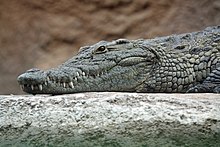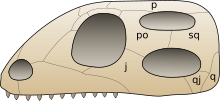ବ୍ୟବହାରକାରୀ:Snip1/ଡାଇଆପ୍ସିଡ୍
| Automatic taxobox help |
|---|
Thanks for creating an automatic taxobox. We don't know the taxonomy of "Snip1/ଡାଇଆପ୍ସିଡ୍".
|
| Common parameters |
|
| Helpful links |
| Diapsid reptiles | |
|---|---|

| |
| Life restoration of an araeoscelidian (Petrolacosaurus kansensis) | |

| |
| Nile crocodile (Crocodylus niloticus) | |
| ବିଜ୍ଞାନଭିତ୍ତିକ ଶ୍ରେଣୀବିଭାଗ | |
| Unrecognized taxon (fix): | Snip1/ଡାଇଆପ୍ସିଡ୍ |
| Subgroups | |
Diapsids ("two arches") are a group of amniote tetrapods that developed two holes (temporal fenestra) in each side of their skulls about 300 million years ago during the late Carboniferous period.[୧] The diapsids are extremely diverse, and include all crocodiles, lizards, snakes, turtles, tuatara, birds and non-avian dinosaurs. Although some diapsids have lost either one hole (lizards), or both holes (snakes), or have a heavily restructured skull (modern birds), they are still classified as diapsids based on their ancestry. At least 7,925 species of diapsid reptiles[୨] exist in environments around the world today (nearly 18,000 when birds are included).
ଗୁଣ ଧର୍ମ
[ସମ୍ପାଦନା]
The name Diapsida means "two arches", and diapsids are traditionally classified based on their two ancestral skull openings (temporal fenestrae) posteriorly above and below the eye. This arrangement allows for the attachment of larger, stronger jaw muscles, and enables the jaw to open more widely. A more obscure ancestral characteristic is a relatively long lower arm bone (the radius) compared to the upper arm bone (humerus).
ଶ୍ରେଣୀବିଭାଗ
[ସମ୍ପାଦନା]Below is a cladogram showing the relations of the major groups of diapsids.
Cladogram after Bickelmann et al., 2009[୩] and Reisz et al., 2011:[୪]
| Diapsida |
| ||||||||||||||||||||||||||||||||||||||||||||||||||||||||||||||||||||||||||||||
ଆହୁରି ଦେଖନ୍ତୁ
[ସମ୍ପାଦନା]ଆଧାର
[ସମ୍ପାଦନା]- ↑ "Those diverse diapsids".
- ↑ http://journals.plos.org/plosone/article?id=10.1371/journal.pone.0118199
- ↑ Constanze Bickelmann, Johannes Müller and Robert R. Reisz (2009). "The enigmatic diapsid Acerosodontosaurus piveteaui (Reptilia: Neodiapsida) from the Upper Permian of Madagascar and the paraphyly of younginiform reptiles". Canadian Journal of Earth Sciences. 49 (9): 651–661. doi:10.1139/E09-038.
- ↑ Robert R. Reisz, Sean P. Modesto and Diane M. Scott (2011). "A new Early Permian reptile and its significance in early diapsid evolution". Proceedings of the Royal Society B. 278 (1725): 3731–7. doi:10.1098/rspb.2011.0439. PMC 3203498. PMID 21525061.
ବାହାର ଲିଙ୍କ
[ସମ୍ପାଦନା]- Diapsida. Michel Laurin and Jacques A. Gauthier. Tree of Life Web Project. June 22, 2000.
- Diapsida Cladogram at Mikko's Phylogeny Archive
